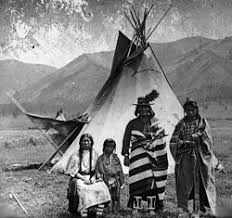
The Kootenai (also spelled Kutenai), whose homeland was in the area west of the Rocky Mountains in what is today western Montana, northern Idaho, and southeastern British Columbia, are generally divided into two groups: Upper Kootenai and Lower Kootenai, referring to their position on the drainage of the Kootenay River. The Upper Kootenai lived near the western face of the Rocky Mountains. By the beginning of the nineteenth century, the Upper Kootenai were more dependent on the annual buffalo hunts while the Lower Kootenai depended more on fish for their subsistence and the buffalo played only a minor role in their economy.
Fishing:
Among the Lower Kootenai, weir fishing was considered a communal affair which was supervised and controlled by the Fishing Chief. According to H.H. Turney-High, in his Ethnography of the Kutenai: “When the Fishing Chief, or some principal man deputized by him, returned from emptying the traps, he filled his own basket as a measure and gave this to the first lodge in the camp circle, the same to the next, and so on until the fish had been evenly distributed.”
Strangers in the camp received the same share as residents.
The Kootenai used a bone device for fishing. This consisted of two fine pieces of bone which were ground to a sharp point at one end. These two pieces were lashed together and then tied to a line. Bait would then be attached and the line cast out (or lowered through a hole in the ice when ice fishing). When the fish swallowed the bait, the line would be jerked to snare the bone device in the mouth.
Deer Hunting:
The Kootenai usually conducted the communal deer hunts during the fall and winter, a time when the animals were fat and had heavy fur. The deer would be driven by beaters toward archers who would shoot them. It was possible to obtain the whole season’s supply of venison in a single day.
In level areas where the deer were known to be abundant, the Kootenai would use a fire surround. Some of the hunters would take pine-wood torches and move out in two directions to form a circle, setting fire to the brush and trees along the way. As the deer fled from the fire, they would arrive at the unfired opening where hunters with bows awaited them.
With regard to leadership during the Kootenai deer drives, Claude Schaeffer, in his University of Pennsylvania Ph.D. dissertation on The Subsistence Quest of the Kutenai: A Study of the Interaction of Culture and Environment, reports: “During the season for holding deer drives, emphasis was placed upon the need for group cooperation rather than individual enterprise. The hunting leader assumed charge of the various activities connected with the drive.”
During this time, no one was allowed to leave camp to hunt alone: to do so would result in a reprimand and possibly banishment.
Among the Upper Kootenai, the meat taken in a hunt, including a communal hunt, belonged to the man who killed it. However, when the hunter turned the meat over to his wife for processing, it then became her exclusive property.
Among the Lower Kootenai, all of the game taken in the communal hunt was turned over to the Deer Chief who then distributed it equally among all of the lodges in the camp, irrespective of whether or not the men in the lodge had been a part of the hunt.
The Lower Kootenai would use a disguise in hunting deer only during periods in which the deer were scarce. The hunter would wear a decoy headdress and conceal his body behind a deerskin robe. Claude Schaeffer reports: “Aided by his supernatural power, a hunter thus disguised was able to ‘see’ game, even though it was rendered invisible by unfriendly shamans of the adjacent Salish.”
Other Big Game Hunting:
Among the Kootenai, elk hunting was an individual undertaking. Elk hunting was usually done after they had returned from the buffalo hunt. As the Kootenai did not care for the taste of elk meat, elk were taken primarily for their hides as it made good robes and tipi covers.
Another big game animal hunted by the Kootenai was the woodland caribou. The caribou were the first of the large game animals to reach prime condition in the spring and so were often hunted in April. According to ethnographer H.H. Turney-High: “They were easy to kill, being so gentle and stupid that the hunter could go right up to them and discharge his arrows without their taking flight.”
The moose was the least important food resource among the Kootenai. Moose were sometimes taken in conjunction with elk and deer hunting, but little attempt was made to specifically hunt moose.
With regard to the Kootenai hunting mountain goats, H.H. Turney-High reports: “The mountain goat is considered very fine food but, as it is a very wise animal and hard to kill, it remained of minor importance.”
With regard to the hunting of bighorn sheep among the Kootanai, Claude Schaeffer writes: “Bighorn were hunted in winter by hunters climbing above them and driving them into drifts at lower levels. There the animals were easily stabbed.”
Among the Kootenai, bears, because of their supernatural importance, were taken only as a result of an accidental meeting.
Buffalo:
After the acquisition of the horse in the eighteenth century, some of the Kootenai bands would cross the Rocky Mountains to hunt buffalo on the Great Plains. The buffalo hunt was often an inter-tribal affair as alliances provided some protection against the war parties of the Blackfoot and other tribes. The Kootenai, for example, often joined with the Coeur d’Alene and Spokan for the buffalo hunt. The Flathead would hunt with the Coeur d’Alene, Nez Perce, and Spokane. The hunt would usually last about four weeks and Kootenai hunters would usually bring back 2-3 horse pack loads of buffalo meat.
For the Kootenai, hunting buffalo meant that they would be traveling in enemy territory. Ethnographer H.H. Turney-High reports: “Since the bison hunt was undertaken under military conditions, the band moved onto the Plains in warlike formation.”
The Kootenai would travel east of the mountains in the summer with 80 lodges. As a large group they felt that they could repel any attack against them. The hunting party included women and children. During the four-week hunt, many hunters would obtain four or five pack-horse loads of meat.
The Kootenai would usually have two tribal buffalo hunts each year. Each of the hunters limited themselves to killing no more than two buffalo per day as this was as much as could be butchered in a day. According to H.H. Turney-High: “To kill more would have been a waste of natural resources.”
The buffalo hunt provided the Kootenai with a store of dried meat. The meat would be dried by hanging strips of meat on a fence-like structure around a fire. Some of the meat would be preserved by making it into pemmican. Unlike other tribes who made pemmican by mixing the meat with berries, the Kootenai used wild peppermint. Ethnographer H.H. Turney-High reports: “It gives the pemmican a strong flavor which they enjoyed as a condiment, but its principal function was to serve as a preservative.”
Unlike some of the Plains tribes, the Kootenai did not use the buffalo’s entrails. According to H.H. Turney-High: “They say they were never so poor that they had to eat such things, and it is probably true that they had enough vegetable and fruit foods to provide enough vitamins.” He also points out: “They express great contempt for the Blackfoot for eating raw liver.”
Bird Hunting:
Among the Kootenai, cranes and geese were the preferred birds. Geese were hunted in the summer using the bow and arrow. Ducks were another staple which were taken using a square, moveable net. Fool hens (a grouse) were hunted by knocking them from the branches with a stick or by using a pole which had a noose attached which was then slipped over the bird’s neck.
The Kootenai did not hunt loons, but they watched loon behavior very closely as this would tell them about approaching storms.
Many Plateau tribes also hunted eagles for their feathers. This was done by digging a pit, covering it with brush, and laying a bait of meat on the roofing. Concealed in the pit, the hunter would wait for the eagle to come down for the bait and then seize it by the legs as it landed on the brush covering. Ethnographer H.H. Turney-High, reporting on the Kootenai, writes: “Only persons with Eagle powers could hope to take the adult bird in this manner, as its powers of resistance are very real.”
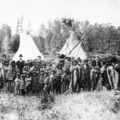
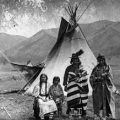
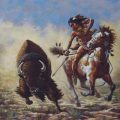
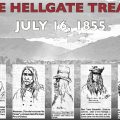
Leave a Reply